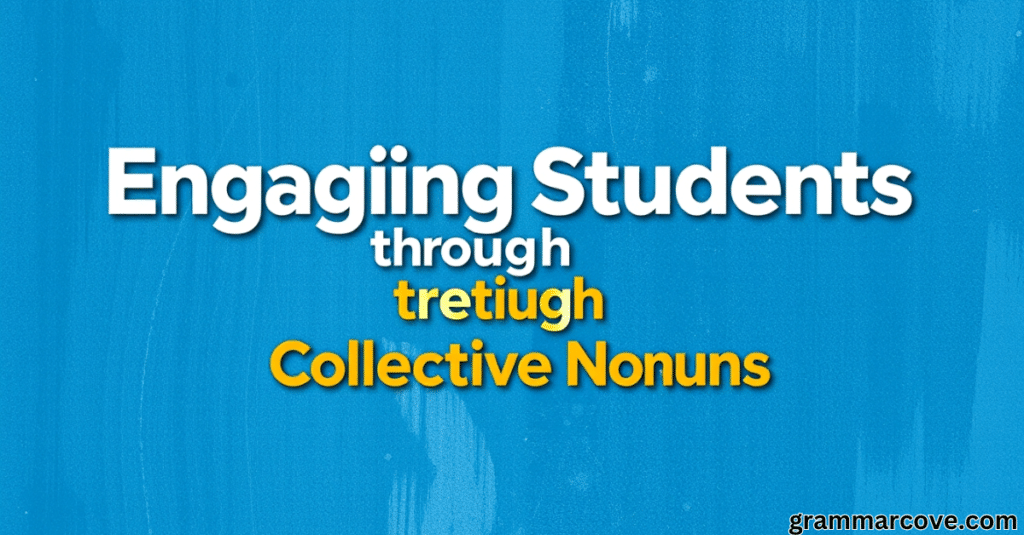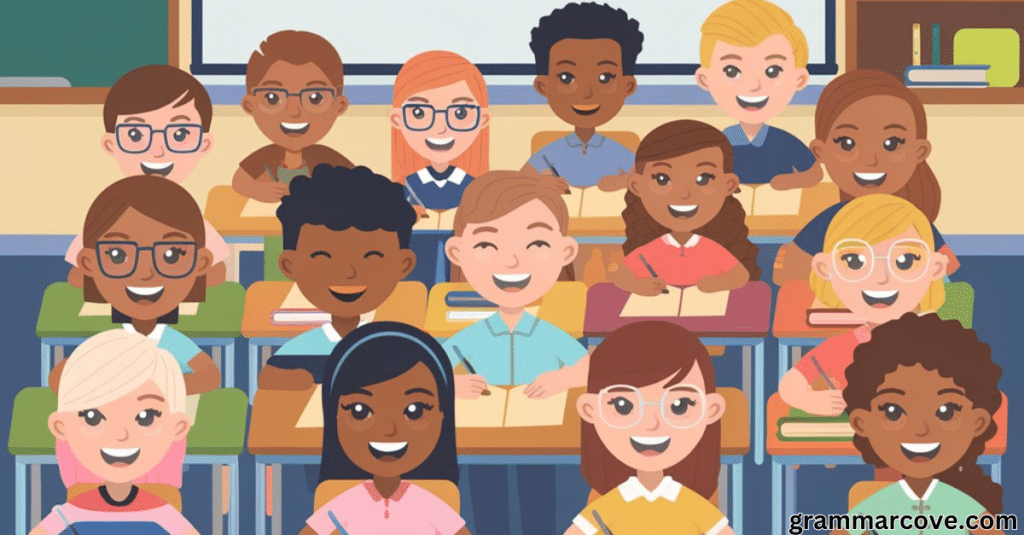When discussing education, the words we choose play a significant role in shaping our understanding and interactions, particularly when it comes to the collective noun for students. The terminology we use not only reflects the dynamics within educational environments but also influences how we perceive and connect with one another as learners.
In this article, we will explore the concept of collective nouns specifically for students, examining the historical origins, cultural perceptions, and various terms used to describe groups of learners. We’ll also incorporate engaging scenarios to illustrate each term’s usage.
Understanding Collective Nouns
Collective nouns are words that refer to groups of individuals or things viewed as a single entity. For example, “flock” refers to a group of birds, while “herd” denotes a group of cattle.
In educational contexts, we often encounter terms such as “class,” “cohort,” and “student body.” Each term carries unique implications and uses, which we will explore in detail.
The Role of Collective Nouns in Education
Using the right collective noun fosters a sense of community among learners and emphasizes the context of their learning. For instance, when a teacher refers to a “class,” it suggests a structured environment where students gather to learn together.
In contrast, the term “cohort” implies a group that progresses through a program together, highlighting their shared academic journey.
Historical Origins of Collective Nouns

When discussing education, the words we choose play a significant role in shaping our understanding and interactions, particularly when it comes to the collective noun for students. The terminology we use not only reflects the dynamics within educational environments but also influences how we perceive and connect with one another as learners.
Understanding the historical origins of collective nouns sheds light on their significance, revealing that many educational terms have roots in historical contexts that influence how we perceive groups of students today.
Example: The Term “Cohort”
The word “cohort” has its origins in the Roman military, where it described a unit of soldiers. Over time, this term transitioned into educational settings, referring to a group of students who move through an academic program together. This historical context highlights the importance of shared experiences in education.
Scenario Example: Academic Discourse
Imagine a university where students embark on a group research project. A professor might send an email to the cohort:
Subject: Research Project Collaboration
Hello Team,
I’m excited to kick off our project! As a cohort, we have the unique opportunity to dive deep into our topic. Let’s leverage our diverse skills and backgrounds for an effective educational process. Please share your initial thoughts by Friday.
Looking forward to collaborating,
Dr. Smith
In this email, the use of “cohort” emphasizes the collective academic journey of the students.
Cultural Perceptions of Student Groups
Different cultures perceive education and student groups in unique ways, which can significantly influence the collective noun for students. The language used to describe these groups often reflects social norms and values, shaping how we understand and engage with the educational experience.
Example: Slang Terms
In informal settings, students often create their own terminology. In the U.S., phrases like “squad” or “crew” might be used among high schoolers to describe their peers. This slang not only fosters camaraderie but also reflects a sense of belonging.
Scenario Example: Group Chat
Consider a group chat among students planning a study session:
Group Chat: Study Squad
Sarah: Hey team! Let’s meet up this Friday to tackle the math homework.
Mike: Sounds good! Our study gang is unstoppable.
Jessica: Agreed! Learning together makes it so much easier.
In this context, “study gang” creates a friendly atmosphere, emphasizing the collaborative nature of their learning.
The Importance of Clarity and Precision
While slang and informal terms can build rapport, precise language is essential in formal educational settings, especially when referring to the collective noun for students. Using the correct collective noun promotes respect and seriousness, ensuring clear communication and understanding among educators and learners alike.
Example: Policy Communication
In a formal email to faculty regarding new policies, a principal might write:
Subject: New Policy for Student Body Participation
Dear Faculty,
I want to ensure that we uphold clarity and precision in our communication regarding the student body. Our new policy aims to enhance student participation in extracurricular activities. Please familiarize yourself with the details before our next meeting.
Warm regards,
Principal Martinez
Here, “student body” is used in a legal context, highlighting the formal responsibilities and rights of students.
Exploring Multilingual Examples
Language is rich and varied, and many educational settings incorporate multiple languages. Understanding how different languages refer to a group of students can deepen our appreciation for cultural diversity.
Example in a Multilingual Classroom
In an international school, a teacher might encourage students to share terms from their native languages:
Subject: Welcome to Our International Class
Dear Students,
Welcome to our class! I’m thrilled to see such a diverse student body this year. Please share how you express “group of students” in your language during our first meeting!
Best,
Ms. Patel
This approach fosters inclusivity and encourages students to embrace their linguistic backgrounds.
The Impact of Historical Influences
The evolution of educational language is shaped by historical events and societal changes. Understanding these influences helps us grasp the significance of terms we use today.
Example: The Term “Class”
The term “class” has been used for centuries to denote a group of students learning together. Its usage can be traced back to the establishment of formal education systems.
Scenario Example: History Lesson
A teacher might conduct a lesson on the evolution of education:
Subject: Historical Perspectives on Education
Dear Class,
Today, we’ll explore the historical origins of our educational system. Understanding how collective nouns like “class” emerged will help us appreciate the academic discourse we engage in today.
Looking forward to a lively discussion!
Best,
Ms. Lee
In this lesson, the term “class” connects students to their educational heritage, fostering a sense of belonging.
Table of Collective Nouns for Students
To summarize, here’s a table outlining various collective nouns used for students, along with their meanings and contexts:
| Collective Noun | Meaning | Context |
|---|---|---|
| Class | A group of students in a structured setting | Traditional classroom setting |
| Cohort | A group of students progressing together | Academic programs or studies |
| Student Body | All students in a particular institution | General reference to all students |
| Group of Students | A generic term for any collection of students | Informal or formal contexts |
| Squad | Informal term for a close-knit group | Casual settings among peers |
| Crew | Informal term for a collaborative group | Group projects or teamwork |
| Team | A group working together toward a goal | Sports or project-based contexts |
Collective Nouns in Legal Contexts
In educational policy and legal documents, collective nouns are used to define the rights and responsibilities of students. Understanding the implications of these terms is crucial for both educators and students.
Example: Legal Communication
In a legal notice regarding student rights, a school district might issue a statement:
Subject: Rights of the Student Body
Dear Students,
As members of the student body, it is essential to be aware of your rights and responsibilities. Please review the attached document outlining these aspects.
Sincerely,
The School Board
In this case, the term “student body” carries legal significance, indicating the collective rights of all students.
The Role of Faculty in Student Collective Nouns
Faculty members play a pivotal role in shaping the educational experience for students. The language they use can significantly influence the students’ sense of belonging and identity.
Example: Faculty Communication
A faculty member might send an email to students about upcoming events:
Subject: Upcoming Events for Our Student Body
Dear Students,
I’m excited to announce several upcoming events designed for our student body. These activities aim to enhance our school spirit and promote community involvement. Please mark your calendars!
Best,
Mr. Davis
In this scenario, “student body” reinforces the idea of a united group of students working together.
The Evolution of Educational Language
As education evolves, so does the language surrounding it. Collective nouns adapt to reflect changes in societal norms and educational practices.
Example: Changes in Terminology
Consider a school that has shifted to a more inclusive language model. The principal might address students:
Subject: Embracing Inclusive Language
Dear Students,
As part of our commitment to diversity, we will be using more inclusive terms like “learning community” to describe our student body. This change reflects our belief in valuing each individual’s contribution to our shared experience.
Warm regards,
Principal Carter
This example illustrates how educational institutions adapt language to promote inclusivity.
The Impact of Technology on Collective Nouns
Technology has transformed education, influencing how we communicate and refer to groups of students. Online platforms have introduced new terms and ways of collaboration.
Example: Online Learning Environments
In a virtual classroom, an instructor might communicate with students via a platform:
Subject: Welcome to Our Virtual Class
Hello Everyone,
Welcome to our class! I’m excited to work with such a diverse student body. Let’s make the most of our time together as we embark on this educational process.
Best,
Ms. Kim
In this digital setting, traditional terms still apply, demonstrating the continuity of language in new formats.
Engaging Students Through Collective Nouns

Using collective nouns effectively can engage students and foster a sense of belonging. Educators can leverage these terms to build community and enhance the learning experience.
Example: Group Activities
Consider a teacher organizing group activities for students:
Subject: Group Activity Announcement
Dear Students,
I’m thrilled to announce our upcoming group of students activities! These sessions will be a great opportunity for you to collaborate and learn from each other. Let’s embrace this chance to grow together!
Best,
Mr. Green
In this scenario, referring to the “group of students” emphasizes the collaborative spirit of the activities.
Conclusion: The Power of Collective Nouns
In conclusion, the collective noun for students varies based on context, culture, and the message being conveyed. Terms like “class,” “cohort,” and “student body” all highlight different aspects of the student experience.
By understanding the significance of the collective noun for students, we can foster a sense of belonging and community in educational settings. Language has the power to shape our interactions, and choosing the right collective noun can enhance the educational process, creating an inclusive atmosphere where all students feel valued and connected.
Next time you’re in an educational environment, consider how the language you use can impact those around you. Whether referring to a group of students as a class, cohort, or something else, remember that your words contribute to the vibrant tapestry of learning together. Embrace the diversity of terms, and let’s celebrate the journey of education!


